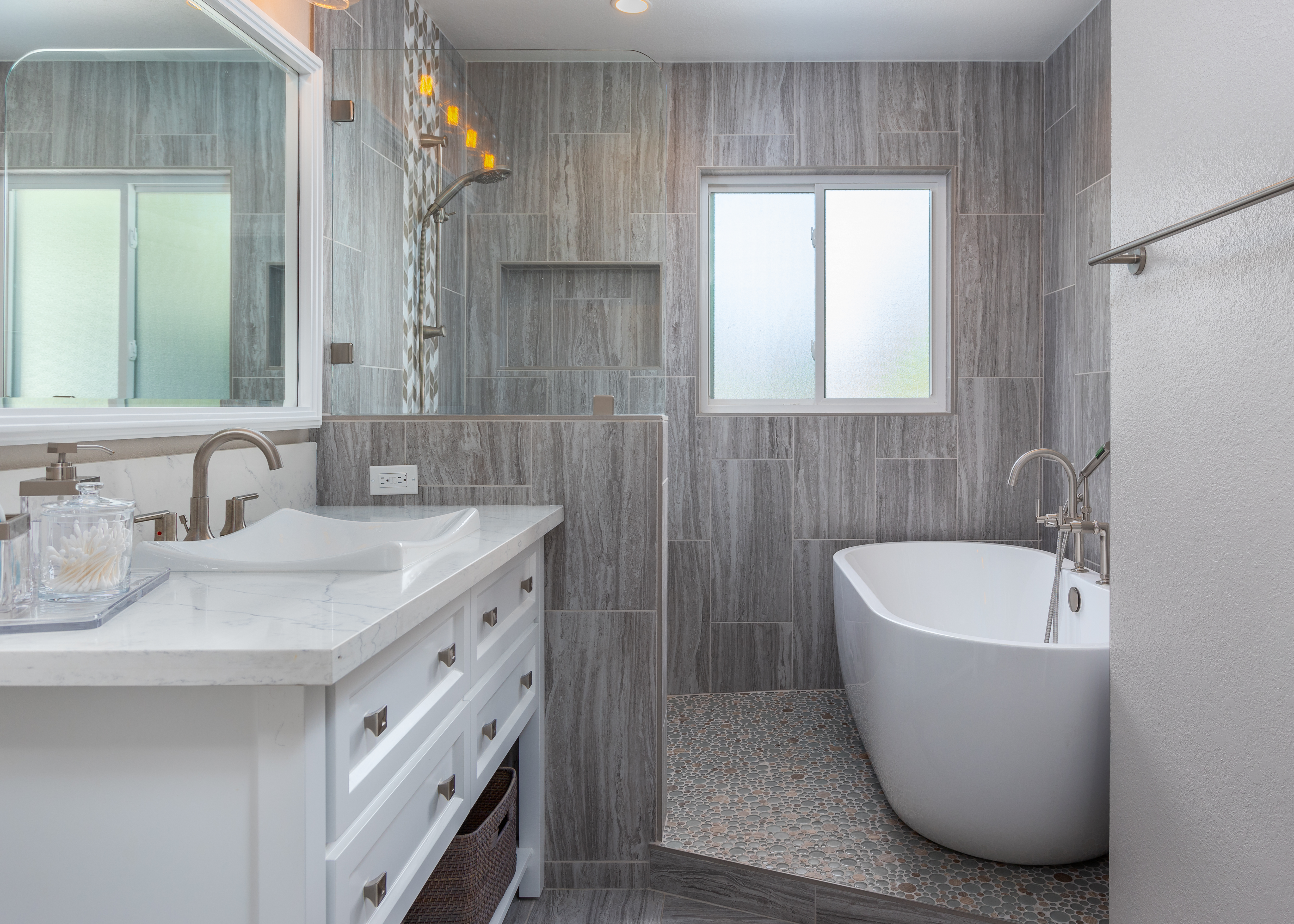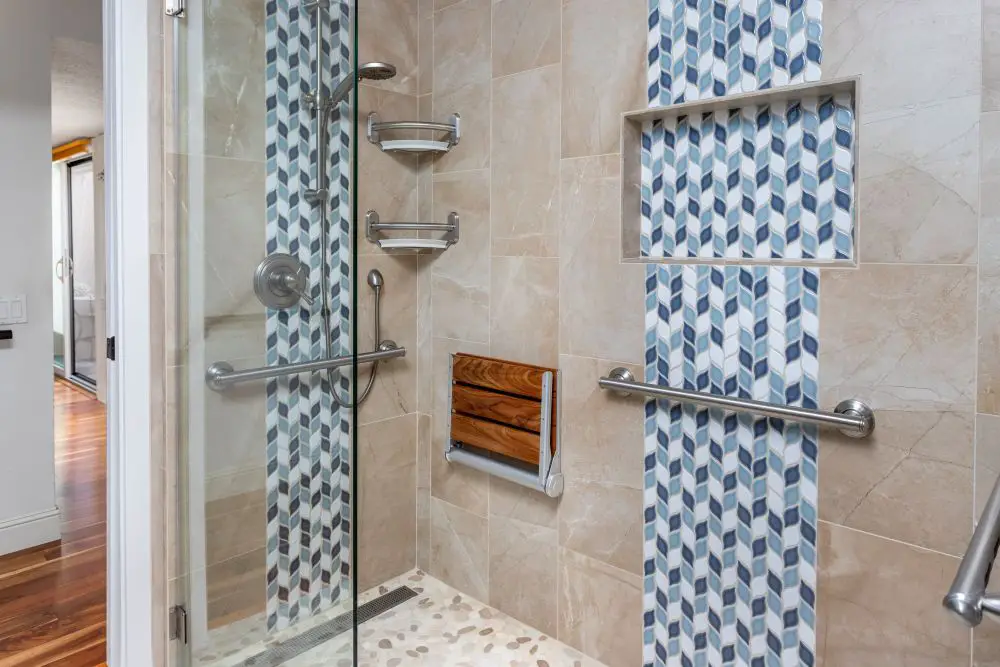By using our website, you agree to the use of cookies as described in our Cookie Policy
The Boss’s Daughter
Aging in Place in Your 30s

Aging in Place… In Your 30s? Yes, Please!
Key Takeaways
-
Accessibility helps everyone, not just seniors — improving daily comfort, safety, and independence.
-
Planning ahead avoids rushed remodels and allows you to make thoughtful, stylish choices.
-
Style and accessibility can absolutely coexist with sleek, modern upgrades.
-
Start with high-impact changes: comfort-height toilets, grab bars, motion lighting, and curbless showers.
-
These upgrades support families, guests, and anyone with medical or mobility needs — while making everyday life easier.
 A modern bathroom with a freestanding white soaking tub beside a gray tile accent wall. The vanity features white shaker cabinets with brushed nickel hardware, a quartz countertop, and an integrated rectangular sink. The shower area is separated by a low half-wall and includes pebble flooring for texture and safety. Warm lighting reflects off the mirror above the sink.
A modern bathroom with a freestanding white soaking tub beside a gray tile accent wall. The vanity features white shaker cabinets with brushed nickel hardware, a quartz countertop, and an integrated rectangular sink. The shower area is separated by a low half-wall and includes pebble flooring for texture and safety. Warm lighting reflects off the mirror above the sink.
Why Aging in Place Isn’t Just for Seniors
When you hear “aging in place,” you probably think of your golden years — ramps, lever door handles, and grab bars that make homes safer and more comfortable.
But accessibility isn’t just for seniors. It’s for anyone who wants a home that works smarter, not harder, for everyone who lives there.
In my house, accessibility isn’t optional — it’s essential. I have three autistic children, which means we need a space that’s safe, easy to navigate, and adaptable to changing routines. Add in the fact that my dad now has mobility challenges after two stem cell transplants and years of chemotherapy, and you can see why “accessible” has become our normal.
And here’s what I’ve learned along the way: accessibility makes life better for everyone.
Style Meets Accessibility
I will never live in a home that doesn’t have these upgrades. Why? Because they make life easier for everyone — kids, guests, busy parents, and those with medical or mobility needs.
And here’s the secret: you don’t have to sacrifice style for function.
At Toupin Construction, we design accessible homes across the East Bay that are equal parts beautiful and practical.
A Real-World Story: My Dad’s Remodel
My dad was in his forties when an unexpected illness forced him to rethink how he lived at home. He went from taking two stairs at a time to needing a ramp from the driveway to the back door.
He converted the downstairs into a main-floor suite with an extended countertop so he didn’t have to bend, a spacious shower, and a comfort-height toilet.
He even redesigned the kitchen so my mom wouldn’t have to carry meals upstairs.
It was a lifesaver — literally. But making those changes in a hurry is stressful. Planning ahead gives you time to make thoughtful, beautiful choices instead of rushed ones.
If you’re curious about other accessibility examples, check out Remodeling for Accessibility: Creating a Home That Welcomes Everyone or Accessible Bathroom Remodel Tips for Aging in Place (East Bay Edition).
My Non-Negotiable Upgrades
While my dad’s changes were born of necessity, mine are about comfort and convenience. Growing up as The Boss’s Daughter means I’ve been spoiled with features I now consider must-haves:
-
Comfort-height toilets
-
Grab bars near toilets and in showers
-
Shower benches and barrier-free showers
-
Under-cabinet lighting
-
Dishwasher drawers (no bending over!)
-
Microwave drawers (also no bending over!)
-
Motion-sensor lighting
Push comes to shove, I could live without some of these — but why would I?
At this point, I’d rather assign the bending-over jobs to my kids.
Even they’ve gotten used to these perks. My five-year-old once grabbed a toilet paper holder like it was a grab bar, broke it, and then complained that it “wasn’t installed right.”
If that doesn’t prove accessibility features become part of family life, nothing will.
Beauty and Function Can Coexist
Accessible design doesn’t mean your home has to look clinical.
Modern accessibility products are gorgeous — and often indistinguishable from traditional décor.
Style-forward accessibility ideas:
-
Matte black grab bars that double as towel rails
-
Tile-integrated benches that blend seamlessly into showers
-
Linear drains that look sleek and modern
-
Barrier-free showers that feel open and spa-like
See more style-driven examples in Why Smart Technology in Bathrooms Is a Growing Trend and The Complete Bathroom Remodel Guide for Bay Area Homes.
Your 5-Step Aging-in-Place Starter Plan
-
Audit your home. Walk through and note obstacles or tight spaces.
-
Prioritize rooms. Start with bathrooms, kitchens, and entries.
-
Choose fixtures. Look for ADA-compliant options that match your style.
-
Hire a licensed contractor. Confirm blocking, clearances, and proper installs.
-
Plan ahead. Add flexibility for future upgrades.
Safety Details That Matter
Small changes go a long way:
-
Confirm wall blocking for grab bars.
-
Choose slip-resistant flooring in wet zones.
-
Keep storage within reach for all users.
-
Always follow manufacturer specifications and local codes.
Our East Bay team knows California-Specific Electrical Codes and accessibility standards — we design every project with safety and compliance built in. An accessible walk-in shower featuring tan tile walls with bold blue geometric accent strips. The shower includes stainless steel grab bars, a hand-held showerhead, and a fold-down teak seat for comfort and stability. A linear drain and glass door make entry smooth and barrier-free.
An accessible walk-in shower featuring tan tile walls with bold blue geometric accent strips. The shower includes stainless steel grab bars, a hand-held showerhead, and a fold-down teak seat for comfort and stability. A linear drain and glass door make entry smooth and barrier-free.
Why It’s Worth It
-
Improves comfort and safety for everyone in the home
-
Reduces risk of injury and daily strain
-
Adds long-term resale value and flexibility
-
Makes your home truly future-ready
For more design inspiration, browse Top Home Remodeling Trends to Watch for in 2025 — many of those trends overlap beautifully with accessibility design.
FAQ
Q: What are the easiest accessibility upgrades to start with?
A: Comfort-height toilets, grab bars, motion lighting, and under-cabinet lights. These are quick wins that instantly improve function.
Q: Will accessible features hurt the style of my home?
A: Not at all. Choose modern finishes, clean lines, and products made for design as much as function.
Q: Should I wait until I “need” accessibility before remodeling?
A: No. Planning now spreads out cost, reduces stress, and lets you enjoy upgrades right away.
Q: Which upgrades make the biggest difference for families?
A: Barrier-free showers, benches, and drawer appliances reduce bending, tripping, and fatigue.
Q: How do I make sure installations are safe?
A: Hire a qualified contractor, confirm blocking for grab bars, and choose rated products.
Final Thoughts
Aging in place isn’t about getting older — it’s about living smarter.
Whether you’re in your 30s, 60s, or anywhere in between, accessibility is an act of care for your future self and your family.
Ready to start your future-friendly remodel?
Contact Toupin Construction to explore design-forward accessibility solutions for your East Bay home.
‹ Back



Comments